Canada is a land of stunning scenery, but a Canadian Rockies road trip from Banff to Jasper hits the ball right out of the proverbial park. Cool alpine villages, snow capped mountains over-looking pine filled slopes, impossibly iridescent lakes and the promise of the big five (deer, elk, moose, wolf and bear) around every corner, are just a few of the reasons to take a Banff to Jasper Road Trip.
Waking up to an RV surrounded by grazing Elk is magical, as is seeing wolves, woolly marmots, fox, grizzlies, deer/fawns, brown bears and moose. Be aware that in early June (the time of our trip) animals are where the grass is. If it is too early for grass in the Rockies it will be easier to find animals in the lower elevations like in Kootenay National Park.
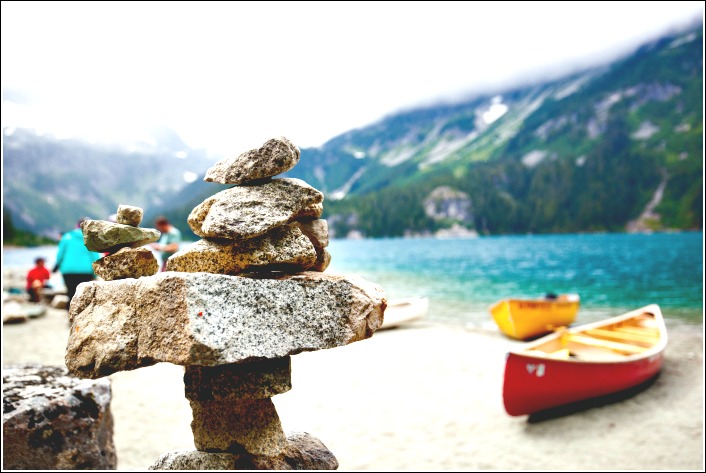
Canadian Rockies Orientation
There are three main townships in the Canadian Rockies.
Banff is the largest and most well-known with about 8,000 residents. Lake Louise is village-like with less than 1,000 residents and minimal shops. Both Banff and Lake Louise are in Banff National Park while Jasper, the only town in Jasper National Park has a population mid-way between that of Banff and Lake Louise.
This post is about a Banff to Jasper road trip but in reality we were on a larger British Columbia road trip starting and finishing in Vancouver, with the Banff to Jasper drive forming a one week itinerary of an overall twenty-one day trip.
This One Week Canadian Rockies Itinerary delivered everything we dreamed of and more.
Travel from Vancouver to Banff
Vancouver to Banff Road Trip
Vancouver is on most Canadian itineraries and was at the top of ours. It was where we collected our pre-booked Canada Dream RV. We love the complete freedom a road trip offers – not only to customise the trip, but to be free to change our minds if needed.
Costs and benefits of RV Rental Canada
For an idea of the costs involved in renting, price compare on line at Motorhome Republic. Having an RV of course means no unpacking or carrying of suitcases. It also means you should have experience driving a larger vehicle and be prepared to learn how to empty the waste water, connect power etc.
Work out proposed distances beforehand as most times mileage must be paid for. Special deals are sometimes available when paid upfront. Paying for extra km later is never a great option.
Expect to pay around $30 per site/night. National Park sites take up to 6 people and 2 vehicles so it is possible to buddy up with friends if the vehicles are compact.
As at the date of publishing Diesel was CAD$1.376/litre in Vancouver. RV’s can use a lot of fuel so ask for the fuel consumption of the vehicle you choose.
We suggest purchasing and using the Wikicamps Canada Phone Ap. for general camp and sight seeing information.
Do I need an International Driver’s License in Canada?
The Answer is Yes. You need both your own Country’s Drivers License and the International one which you organise before leaving home.
Best time to Road Trip in Western Canada
Avoid July/August as it is peak season and the kids are on school holidays. So June and September are the obvious choices with less crowds and OK weather.
Driving in the Rockies could be dangerous outside of these times for the inexperienced and familiarity with snow chains would be an advantage.
For those interested in the Vancouver to Banff round trip, I’ve added our basic route from which we detoured, including to Vancouver Island.
We recommend a Vancouver to Banff road trip, preferably in an RV, but if driving is not for you there are other options.
Vancouver to Banff Train
There are two trains that go to the Canadian Rockies. The Rocky Mountaineer (more expensive) arriving in Banff or Via Rail (Vancouver to Jasper). Read about them both here.
Vancouver to Banff bus
The National Carrier “Greyhound Canada” takes 13 to 16 hours to do the Vancouver to Banff trip and is the cheapest option.
If you find yourself in Banff without a vehicle, or if winter driving is not for you, Viator do have many tours from Banff.
National Park Pass
We arrived in the Canadian Rockies via Kootenay National Park and the road trip from Banff to Jasper would take us through Banff National Park plus Yoho and Jasper National Parks so we purchased a National Parks Family Pass at Radium National Parks Office. You will require a national park pass for Banff and Jasper.
A Parks Canada Discovery Pass starts at $57.90 and can be purchased on-line (valid for one year). There is no need to wait in line when you have a pass (a bonus in Peak Season) but you can also purchase by days if that works out cheaper. ($8.90/day).
This One Week Canadian Rockies Itinerary delivered everything we dreamed of and more. National Geographic agree with us – calling it Alberta’s Best Road Trip and like us, suggesting Banff as the Starting Point.
1. Banff to Lake Louise
Banff Town 2 nights
Banff Itinerary – Choose from:
- Hoodoos Walk*
- Lake Minnewanka Walk/Boat Tours*
- Photo Op – Banff Avenue – shop and National Park Office*
- Check Out (or Check In) or Splurge at the famous Fairmont Banff Springs Resort*
- Whyte Museum of the Canadian Rockies
- Banff Gondola to Sulphur Mountain ($74.81 – you can climb it for free if you have 2-3 hours)
- Cave and Basin National Historic Site
- Banff Upper Hot Springs – at Lower Gondola Terminal (A bargain at $11.35 for Thermal Waters Pass)
- Banff Park Museum – Century Old Museum – Old Canadian Pacific Railroad Building
- Luxton Museum – Indian
- White Water Rafting
From it’s inception Banff was a tourist town. With a main street planned to give the best view of Cascade Mountain, this town is meant to impress.
We managed to do the first four items on the above list and recommend them all. I would also suggest a visit to the Banff Upper Hot Springs. We did not indulge as we had soaked in Radium Hot Springs the previous day. There is never enough time!
See our Banff Destination Guide.
Banff Avenue with Cascade Mountain backdrop.
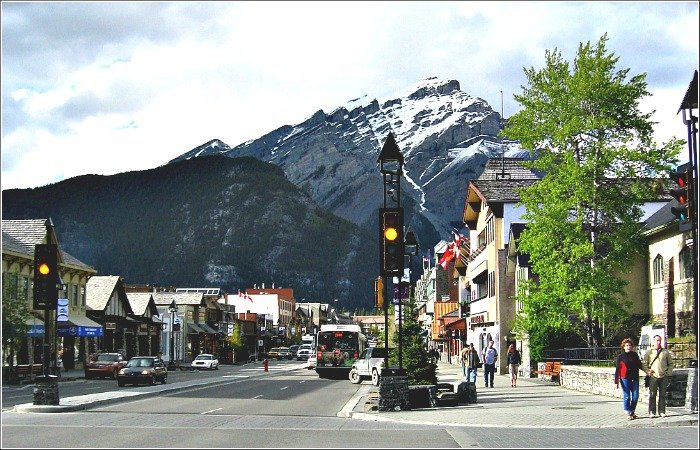
The list of adventure activities available in and around Banff is huge. Take your pick from canoeing and kayaking, white water rafting, skiing and snowboarding in season and cycling. Tours include Banff Town walks, wildlife tours (morning and evening) Historic Banff Walks, Grizzly Bear tours and tours to further afield. See Viator Tours here.
The Bow Valley Parkway Scenic Route 1A
Castle Mountain.
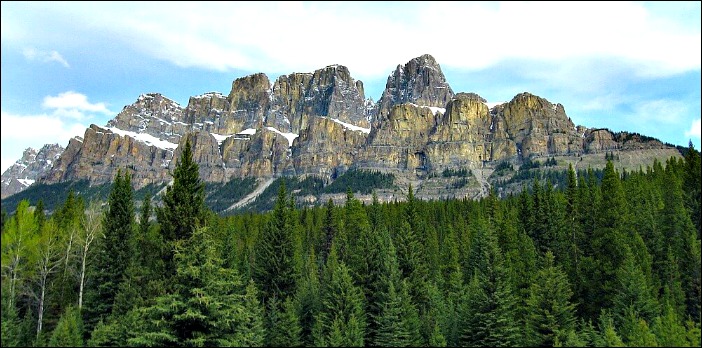
Leave Banff, via the Trans-Canada and take the first turn to Bow Valley Parkway, a scenic 50 km road running beside the Trans-Canada Highway connecting Banff and Lake Louise.
The Parkway is known for it’s bears, big horn sheep and elk, although we didn’t see any on this particular road. Vehicles are banned between 8 pm and 8 am to enable animals to interact without human intervention. This is not policed and I fear that some people don’t know or care about this initiative.
There are loads of exceptional photographic opportunities on the Bow Valley Parkway and we highly recommend taking it.
The Trans-Canada is a busy highway with no opportunities to stop, although it is possible to divert at Castle Junction, to join the Bow Valley Parkway, or head down the Banff Windermere Highway (Hwy 93S) to Kootenay National Park and Radium Hot Springs.
Castle Junction is the mid-way point between Banff and Lake Louise.
Johnston Canyon
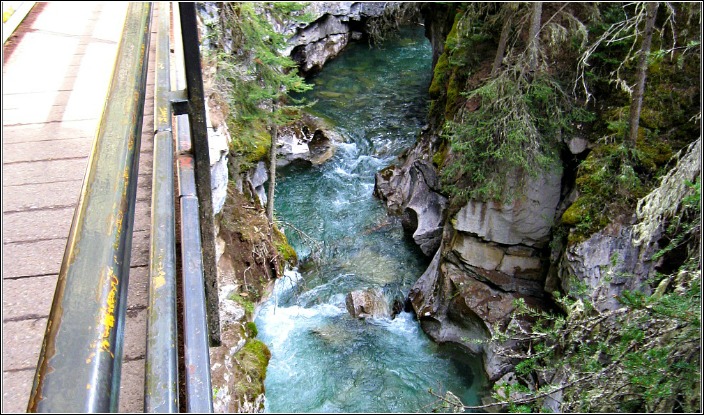
Twenty-five kilometres west of Banff, along the Bow Valley Parkway is the trail head for this easy and accessible hike. There is a quite substantial parking area at Johnston Canyon, so if the Bow Valley Parkway has cars parked along the edges, it suggests the car park is full. In this case I would keep on driving – there’s plenty more to see!
In early June and early in the day with only one bus load of tourists sharing the trails, we enjoyed the Lower and Upper Canyon.
Leave Banff at 8 a.m. to miss the crush. It is an easy walk with boardwalks attached to the Canyon Walls in places and one crossing of the canyon. The walk can be extended beyond the Upper Falls to the Ink Pots (coloured pools) if you have the time and inclination. Ink Pots are usually surrounded by marsh lands, the favourite hang out for moose. We saw moose in the forested marsh beside the Kootenay National Park ink pots.
Other things to see and do on the Bow Valley Parkway:
- Picnic and birdwatch at Muleshoe,
- day hike to Rockbound Lake,
- Storm Mountain Lookout,
- Castle Lookout
- Morant’s Curve.
Lake Louise 1 night
The diva of all Lakes – Lake Louise – named after the fourth daughter of Queen Victoria is the next stop. Stay overnight to experience the lake in the afternoon and again in the crush-free morning.
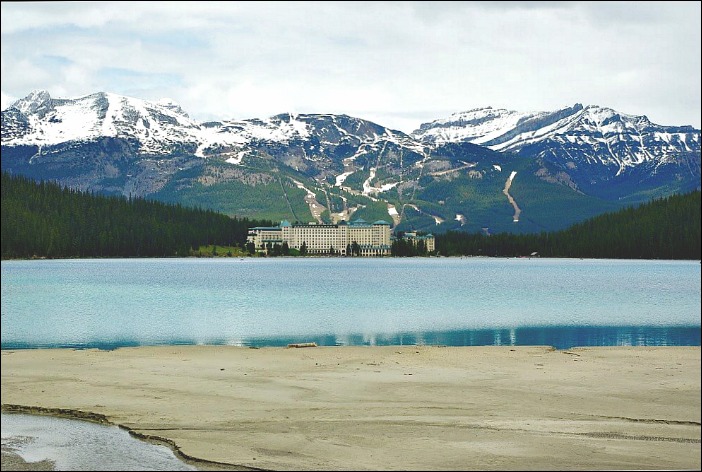
Lake Louise village, aka Samson Mall, is beside the Trans-Canada Highway and includes a National Park visitor centre, grocery, bakery, deli, grill, bar (incl. takeaways) and sporting goods store, with gas stations nearby. Collect supplies here on the way to the Campgrounds or not if you are intending to fulfil a dream and stay at Fairmont Lake Louise.
The Lake Louise Ski Resort and gondola is situated on the other side of the Trans-Canada Highway.
At the lake itself there is only the Fairmont Lake Louise complex and two huge parking areas with amenities. There is no actual town like at Banff or Jasper.
Admire Louise from the lakeside path, a canoe on the Lake, while taking afternoon tea in the Fairmont Chateau Lake Louise dining room, the Lake Louise Gondola (on the other side of the highway) or continue the lakeside walk to the dramatic Plain of the Glaciers Tea House. There is another Tea House track, which was not open during our visit.
Read all about Lake Louise and the Tea Houses in this post.
Do not miss Lake Louise, it is gorgeous, just be wise about your timing.
This photo shows the far end of Lake Louise looking up to the Plain of Six Glaciers. The track to the tea house is visible low in the middle right of frame. The path starts to climb shortly after it rounds the corner and leaves the lake.
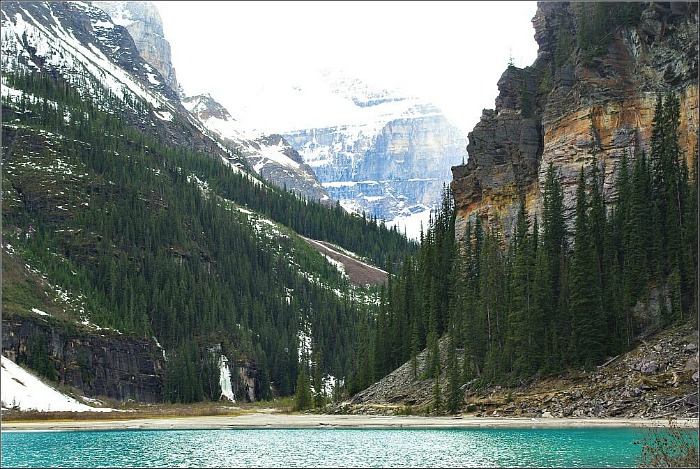
Morraine Lake
Morraine Lake is part of the Valley of the Ten Peaks and is close to Lake Louise.
In July and August when the season is in full swing, the road to Morraine Lake closes when the carpark is full. This necessitates parking in Lake Louise and catching a bus to Morraine.
The lake has ten stunning peaks as a backdrop. The Ten Peaks, were originally named 1 through 10 in the language of the Nakoda Indians.
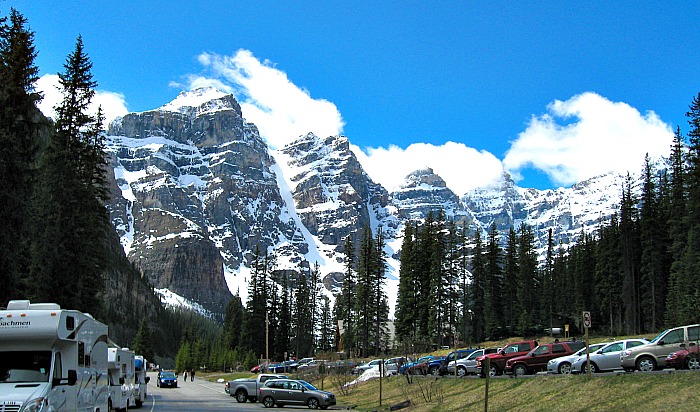
In early June we had no trouble driving there in our RV, although we did drive through hail on the wonderful mountain road. Morraine is deeper than Lake Louise and melts a little later. It is yet another drop-dead gorgeous lake.
If it is early June or even late May and Lake Louise and Morraine Lake are still frozen, head down to Emerald Lake through Kicking Horse Pass into British Columbia.
We arrived at Lake Louise around mid-day and used the first afternoon to walk beside the lake and up to the teahouse. After visiting the lake again in the morning for photos minus the crowds, we visited Morraine Lake and the Lake Louise Gondola at the ski fields.
We then departed Icefields Parkway and drove down through the Pass to spend the night at Kicking Horse Pass campground.
Kicking Horse Pass and Emerald Lake Detour – 1 night
Emerald Lake is a spectacular turquoise/blue lake, with great reflections and an intimate atmosphere. It has a great circumnavigating lakeside walk. Being at a lower altitude, Emerald Lake will most likely have thawed in the first week of June.
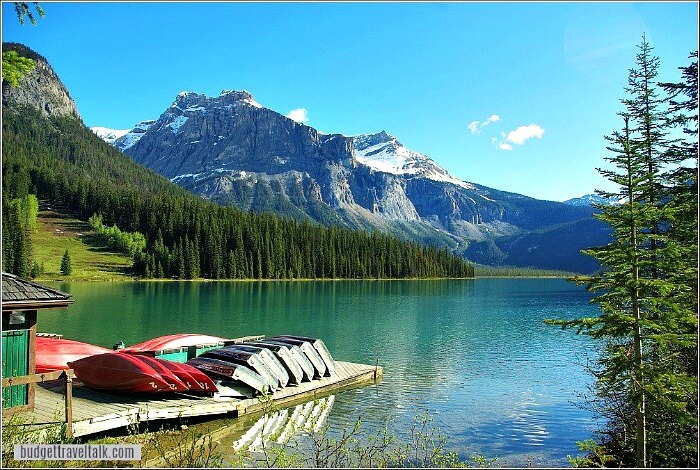
The 5.2 km path stays close to the shoreline passing through pine forest with many opportunities for “reflection” photography and a real chance to leave the crowds behind the further you walk. If you walk it anti-clockwise you will see the best views and reflections first.
There are also canoes available to hire.
The Lake is Glacier fed which is why it has the lovely turquoise colour, but nearby is Kicking Horse River and natural bridge. You can read about them in Detour to Emerald Lake.
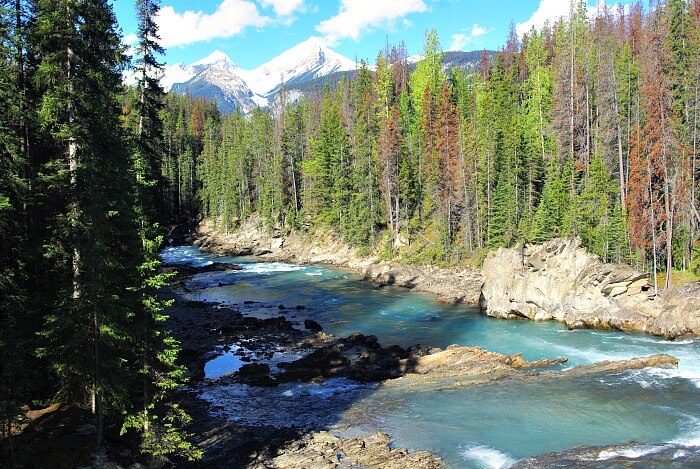
Don’t miss the spiral tunnel viewing points in Kicking Horse Pass where the trains gain and lose altitude on the Rocky Mountain route.
On average, 25 to 30 trains pass through the Spiral Tunnels daily.
- From the viewpoint 7.4 km east of Field on the Trans-Canada Highway, you can see the Lower Spiral Tunnel in Mt. Ogden.
- The Upper Spiral Tunnel in Cathedral Mountain can be seen from the pull-off 2.3 km up the Yoho Valley Road.
2. Lake Louise to Jasper Drive
Rejoin the Banff to Jasper Road Trip after detouring to Emerald Lake.
Starting from Lake Louise in Banff National Park and finishing at the Town of Jasper in Jasper National Park, the Icefields Parkway, also known as Highway 93, carries on where the Trans-Canada and Bow Valley Parkway finish.
The distance from Lake Louise to Jasper is 232km and it is bulging with huge mountains, glaciers, lakes, hikes and canyons. There were times, especially driving through Big Bend in our RV when we felt dwarfed by sheer grandeur.
The distance from Lake Louise to the Columbia Icefield is 132 km and the drive takes about 2 hours – more of course when stops for attractions are factored in.
Things to see on the Icefields Parkway:
- Bow Lake
- Peyto Lake
- Mistaya Canyon
- Weeping Wall
- Big Bend and Big Hill
- Cross over seamlessly from Banff to Jasper National Park
- Columbia Icefield
- Sunwapta Falls and Canyon
- Athabasca Falls and Canyon
- Hike the Valley of the 5 Lakes
Bow Lake

Leaving Emerald Lake behind we soon rejoined the Icefields Parkway. The downside to being crowd free in the first week of June is that some of the lakes were frozen. That was the case with Herbert Lake, and Bow Lake. Regardless of the state of Bow Lake which seemed to melt before our eyes, this is a good place to view the Crowfoot Glacier, with it’s three glacier “feet”.
Peyto Lake
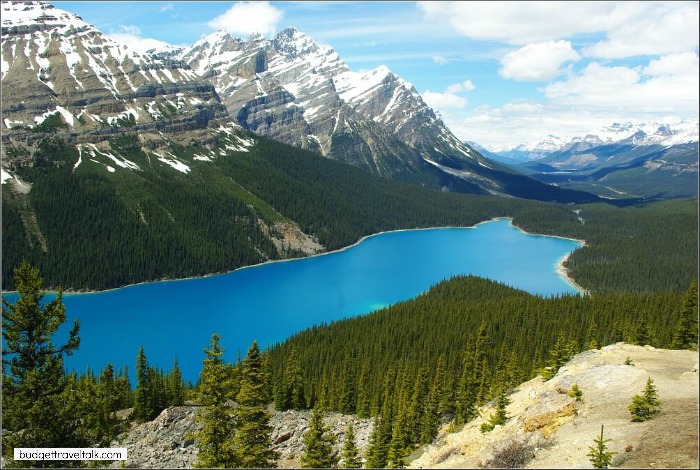
I get a fright when I think that we actually contemplated not walking in to this viewpoint. The car park and access road were snowbound but there was a snow-free walkway and we took it.
Peyto Lake is the most visually stunning of all the lakes. Seen from high above it has a crisp, clear quality – brilliantly blue in a impressive landscape. Truly spectacular and because of it’s lower altitude it was thawed. The walk in didn’t take long and there were cute woolly marmots in the snow beside the walking track.
Mistaya Canyon
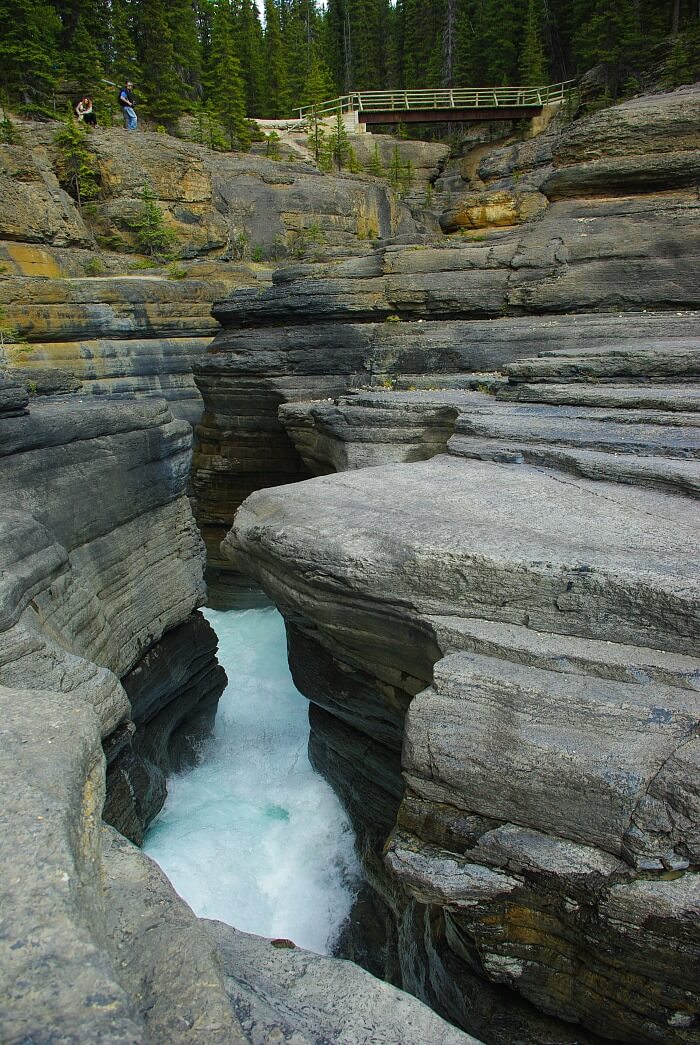
Mistaya is the first of three Canyons. Still in Banff National Park, Mistaya is easy to access, just 10 minutes walk off the Icefields Parkway and known for it’s curving rock walls created by the power of water. Views up-river are to Mt. Sarbach. Worth a quick look but there are two more to come.
Weeping Wall
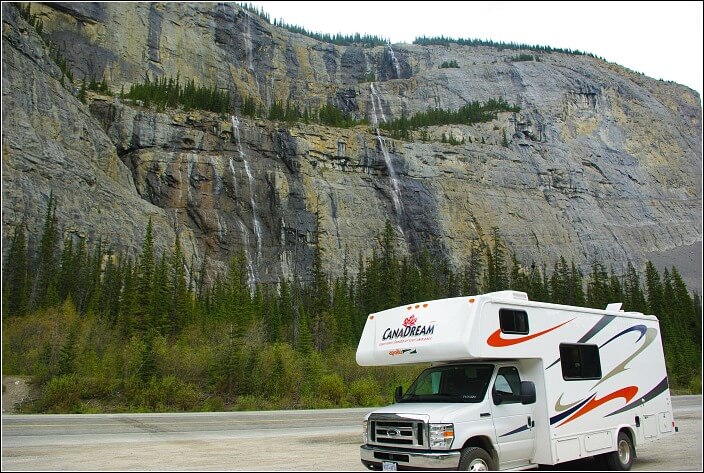
In summer the wall of rock is covered in weeping waterfalls, but in early Spring it has just a few. In Winter it is a solid sheet of ice, enticing climbers from all around the world. To make it to the top of Weeping Wall Ice Climb is a feather in any Alpinist’s Cap. The rest of us should stay back on the roadside to avoid falling chunks of ice.
Big Bend and Big Hill – 1 Night
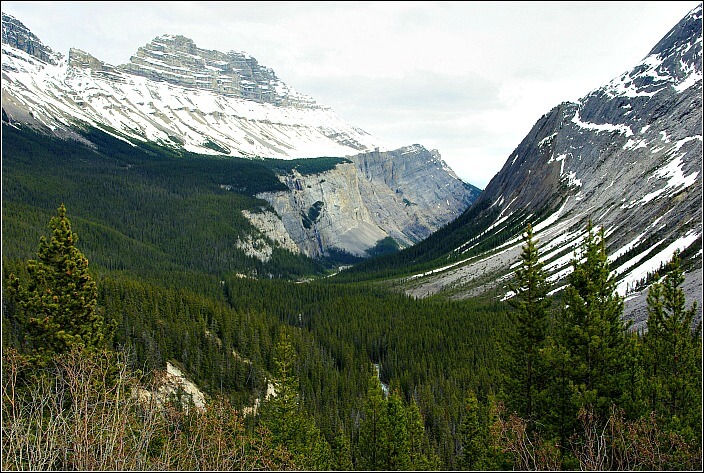
See the road at the base of the hill? Big Bend is a hairpin turn, wrapping around Big Hill. The road clings to the edge of the mountain, with awe-inspiring views up to towering mountains and down to the river.
Jasper National Park
We are now in Jasper National Park, an 11,000 sq.km. park and second largest dark sky reserve in the world. Bring a Digital SLR, wide angle lens with low aperture and tripod if you want to take some starry night skies home with you.
We spent the night at the rustic Wilcox Creek Campground located just before Big Bend. The Bortle Scale measures the darkness of the Night Sky in 9 levels and Wilcox Creek is #1/2 – one of the darkest night skies available on Earth.
This campground is 107 km south of Jasper and 111 km north of Lake Louise with 46 terraced campsites. The internal campground road turns sharply as it zig zags up the hill side. Scrapes suggest larger RV’s have a tough time taking the turns. The Icelands Centre RV campground is just 1km further along the road will do nicely for larger rigs.
We revelled in the night sky, campfire and the quiet white landscape, broken only by screams as a bird swooped down and stole sausages from a nearby camper. This campground is a trailhead for Wilcox Pass (Big Horn Sheep and Mountain Goats along the trails) and Parker Ridge is 2 km east with views of Saskatchewan Glacier. Parker Ridge is a two hour hike and is so popular that Parks Canada close the trail late Spring to Early Summer to help preserve it. There are many more trails nearby. If you like hiking this is one of the best places to do it.
Columbia Icefield
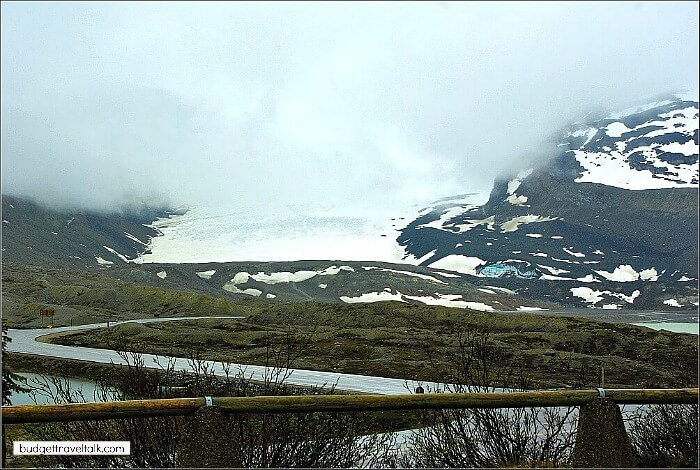
The fields number 30 glaciers and are the largest south of the Arctic Circle. The Columbia Icefield Discovery Centre has a great natural history museum and the road itself drives right past Athabasca Glacier. I don’t know if the glacier has retreated with climate change, but you should still be able to walk to the toe of it.
A guide is needed to actually walk on the Glacier. We intended to do an Icefield Parkways Tour with Brewsters – a fun mix of half monster truck and half tour bus.
The weather closed in when we arrived, so we took Mother Nature’s hint and aborted the mission. Fortunately we had already had a different glacier adventure in New Zealand.
Columbia Icefield Glacier Skywalk
This 1 km cliff edge skywalk leads to a glass viewing platform over the Sunwapta Valley some 280 metres below. ($34). Opened in May 2014, it’s views are amazing in good weather. Personally, I think a Glacier walk with the Ice Explorer Glacier Tour would be more rewarding, although doing both would be the ultimate option, time and budget permitting.
I wouldn’t pre-book for either due to the fickle weather, but you can read about them here and see a photo of the Glacier Skywalk.
Sunwapta Falls and Canyon
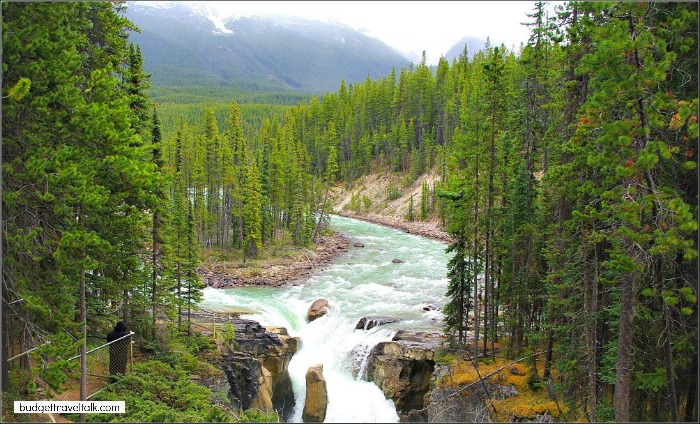
Fed by waters from the Athabasca Glacier, there are actually two waterfalls not one. Walk for 2 km to come to the second less visited one. The 25 km hike to Fortress Lake and Hamber Provincial Park also starts here, following the Chaba River Valley known for it’s bears and moose. If you do this hike make lots of noise to warn the bears.
Sunwapta Falls Resort Restaurant.
Located close to Sunwapta Falls, this is the only food stop between Jasper and the Icefields Centre. We popped in and checked out the food options (pricey) and the souvenirs and decided to picnic from the RV instead, but their soups looked good and would be irresistible on a cold wet day.
Athabasca Falls and Canyon
On the Upper Athabasca River, these falls are famous for the powerful force of the raging water. It sounds strange to say, but the river just kind of falls over a cliff and the rock shapes and cut outs make for some great photos. Go on the 1km falls hike with interpretive signs and walk down to the gorge.
30 mins – 1.5 hours
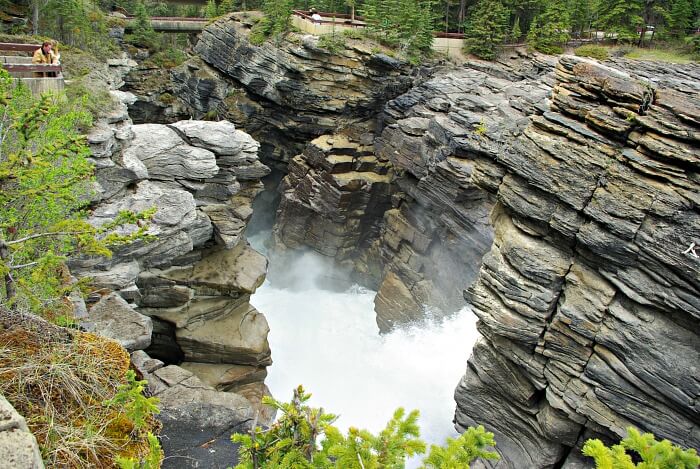
Valley of the Five Lakes
The five lakes trail is the one that got away. The five lakes themselves are varying shades of green and blue depending on conditions. There are even a couple of red adirondack chairs at one of the lakes for photo opps – Canada Parks like to sprinkle these through their parks. Take bug spray and bells to warn bears.
The first km or so of this hike, before the lakes are reached, is the least interesting, but hang in there because these lakes (the 3rd and 4th are the best) are considered a natural wonder in Canada.
- Trailhead just under 9km south of Jasper traffic lights on the Icefields Parkway
- 4.5 km circuit
- 1.5 to 2 hours
3. Jasper Alberta – 2 nights
Jasper is a mountain town with character and an interesting mix of people. Arriving there felt a little like coming home for me even though it is nothing like my home. I guess what I mean is I felt like I could live there, albeit in the warmer months. I loved it’s cafes and shops and the feeling that every person there was on an adventure.
Even doing the laundry (at Snow Dome) is a fun thing to do in Jasper. It is so warm inside the Laundry – a bonus when it is cold out – and it has a coffee shop serving great coffee.
Jasper train station is on the east side of Connaught Drive, at the main entrance to the town from Banff. It verges onto open country and distant snow capped mountains in the east with the town spreading out to the west. It is scene that is firmly planted in my mind.
The budget friendly Astoria Hotel is a Chalet type building in a great position and they offer free parking. All parking is free in Jasper. On-Street is time limited but off-street parking is long term. There is off-street parking at the nearby train station.
What to do in Jasper
- Pyramid Lake*
- Maligne Lake (Cruise) and Malign Lake Canyon*
- Miette Hot Springs*
- Annette and Edith Lakes
- Jasper-Yellowhead Museum
- Jasper Sky Tramway.
- Skiing and Snowboarding at Marmot Basin
- Visit the quirky SnowDome Laundry for washing plus coffee*
- Visit the Jasper National Parks Office and Info Centre*
- Hiking (try the famous Skyline Trail and the shorter Valley of the 4 Lakes)
- Mountain Biking Jasper (collect a mountain biking guide from the Jasper Info Centre),
- Rock climbing (many established climbs plus beginner course),
- Horseback riding,
- White water rafting (May to September).
Pyramid Lake and Patricia Lake, Jasper National Park
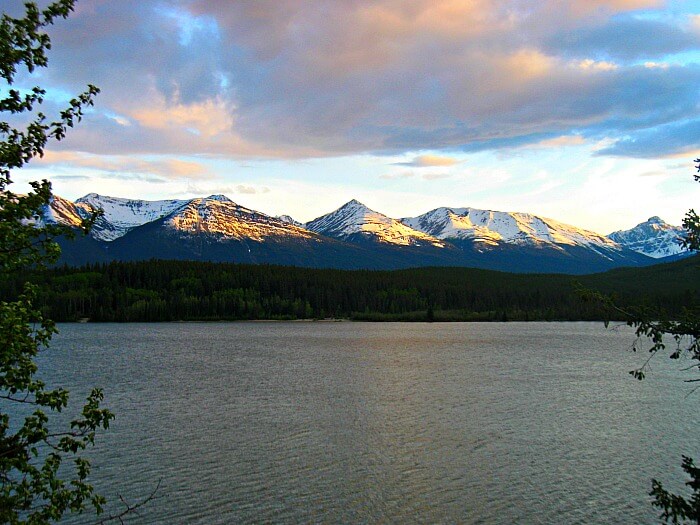
This small alpine lake is just 7 km from town so why not visit? There are picnic tables so pack a picnic or take food to BBQ. Canoes and windsurfers, hiking and horseback trail rides not to mention animal spotting is what Pyramid (and Patricia Lakes) are known for.
Maligne Lake and Medicine Lake, Jasper National Park
Maligne Lake showed us it’s dark and moody side with the sun only peeking through momentarily. It is however, a hugely popular destination as you can see by the line-up of boats. The water is described as baby blue and I can sort of see that. Fill up before leaving Jasper as there are no gas/fuel stations on this route.
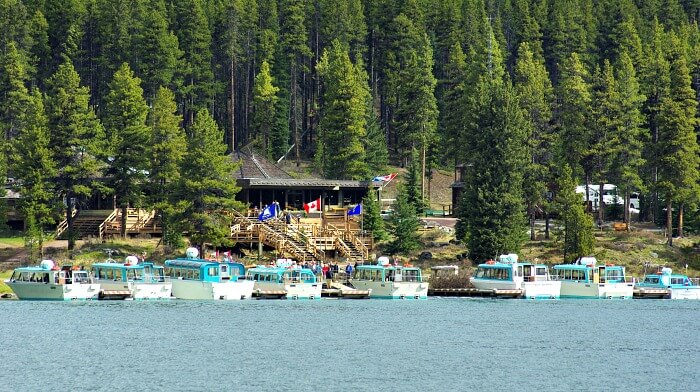
There was scarcely another person at Maligne Lake during our visit. We fossicked along on the shoreline uninterrupted, talked to the dog and hunted in the souvenir shop before continuing on the lakeside road to Medicine Lake at the end of the Maligne Lake Road.
Taking a Maligne Lake Boat Cruise is one of the best ways to get to Spirit Island. The only other option would be a long canoe trip. This is the island which features in all the best photos of the lake and because of the runoff from nearby glaciers the water there is a pretty blue. Aussie’s in the audience be aware that if the boat has a guide onboard tipping is kind of expected.
Afterward we backtracked to Maligne Canyon, the deepest of the four canyons we saw on the Banff to Jasper road trip.
The road runs right beside Medicine Lake (see bottom right corner of the collage below).
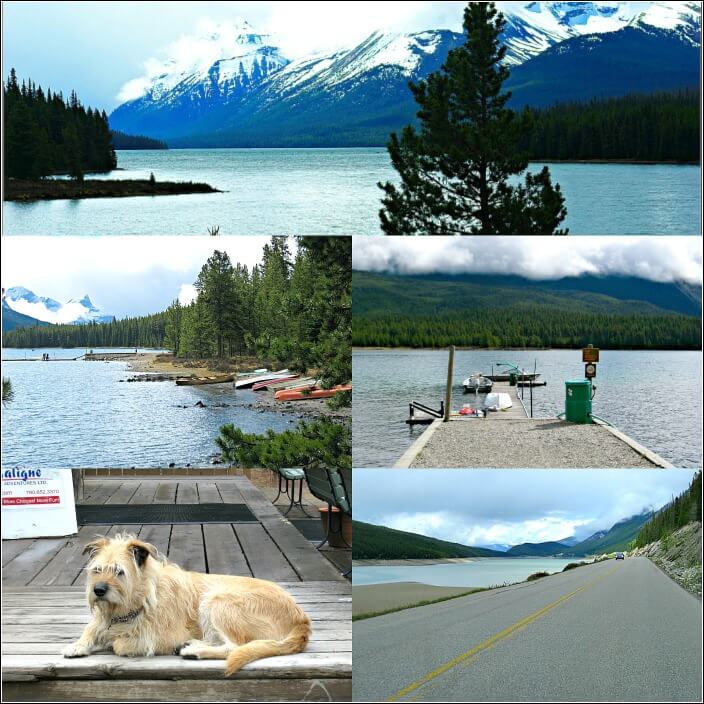
Miette Hot Springs, Jasper National Park
Make time for a soak in Miette Hot Springs. Hot Springs in Canada are so cheap and good! These outdoor pools have views of the Fiddle River Valley Hills. The water comes out of the mountain at 54 degrees C and cools to 38 and 40 before reaching the pools. Be warned that two of the four pools are cold!
It has an interesting little gift shop where we collected a few gifts and there is a handy cafe. A short walk leads to the source of the springs or there is an 8km Sulphur Skyline Trail with spectacular views.
We saw foxes before and after visiting Miette Springs and a black bear and elk with huge antlers on the way home to Jasper.
Prices start from $7.05/adult.
Jasper Tramway
The Jasper Sky Tramway is 7km from Jasper Town and quite close to where we were staying at Whistler Campground Jasper. Head south out of town and turn into Whistlers Road. The Tramway Carpark is 10 minutes from Jasper Town.
On a clear day you can see the Columbia Icefield 75 km away from the top. It’s more reasonably priced than the one at Banff, but we were so happy with our experience on the Lake Louise Gondola the previous day, that we didn’t feel the need to partake again so soon.
It is best to buy your ticket in advance to avoid hold-ups on the day.
- Remember it will be windier and colder at the top.
- Wear walking shoes as there are walking trails.
- Bring a camera.
- Take your own filled water bottle.
- There is a small restaurant at the top.
Jasper Information Centre
Jasper National Parks office and Info Centre is a quaint stone/timber cabin in a green park lodged between two of Jasper’s main streets. We found it useful for trip planning information, small gifts and interesting books and visited several times.
We purchased a book showing how to identify animals by their scat (poo). This seems hilarious in retrospect, but we’d been on one too many hikes wondering whose trail we were following!
Ask here for the Day Hiking Guide (including Valley of the 5 Lakes Hike).
500 Connaught Drive, Jasper Town
Where to Camp near Jasper (Town)
Whistler Campground Jasper is just 3 km from town at the base of Whistler mountain. It is a huge 780 site park full of elk grazing on green grass, the occasional bear and wolf as well as campers. Each campsite is quite private with natural screening plus a moveable table and fire pit. You will be surprised to know that it does fill up. The sites are arranged in loops, not just one huge space, which makes the experience feel more intimate, but you might still want to drive to the shower block!
STOP PRESS:
WHISTLER CAMPGROUND IS CLOSED OCTOBER 2018 THROUGH TO THE SPRING OF 2020 FOR RECONSTRUCTION.
With Whistler Campground Jasper providing nearly 800 of the 1800 campsites in the whole national park, this closure will put a huge dent in the number of available camp sites. Plan and book well in advance for a campsite in Jasper 2019. Read about other suitable Parks Canada Campgrounds and follow the link for bookings here.
Bookings for 2019 open on January 8 2019 for Wapiti, Wabasso and Pocahontas campgrounds. Other grounds don’t take advance bookings. Of course if you are visiting in early June like we did you will probably be able to nab a spot somewhere, although there is no denying the closure of Whistler Campground will change things in 2019.
Driving the Canadian Rockies was an incredible experience and I didn’t want it to end! I had the crazy idea of abandoning the rest of our twenty-one day road trip in order to stay on in the Rockies. Luckily Marty intervened with the voice or reason and we continued our trip through British Columbia.
Have you ever resisted leaving somewhere you visited and fell in love with?

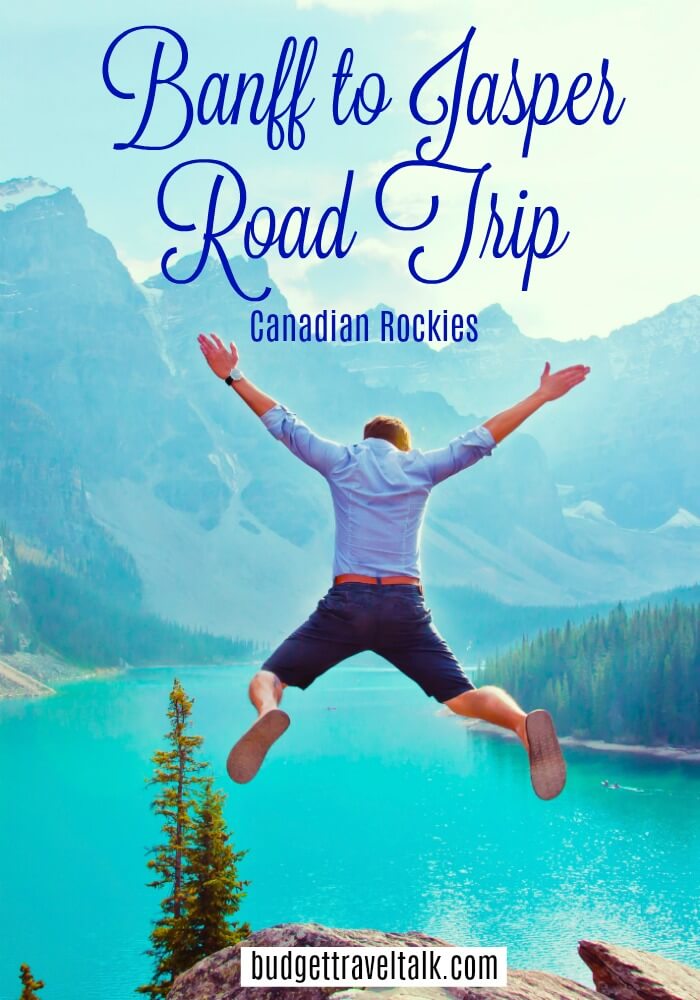
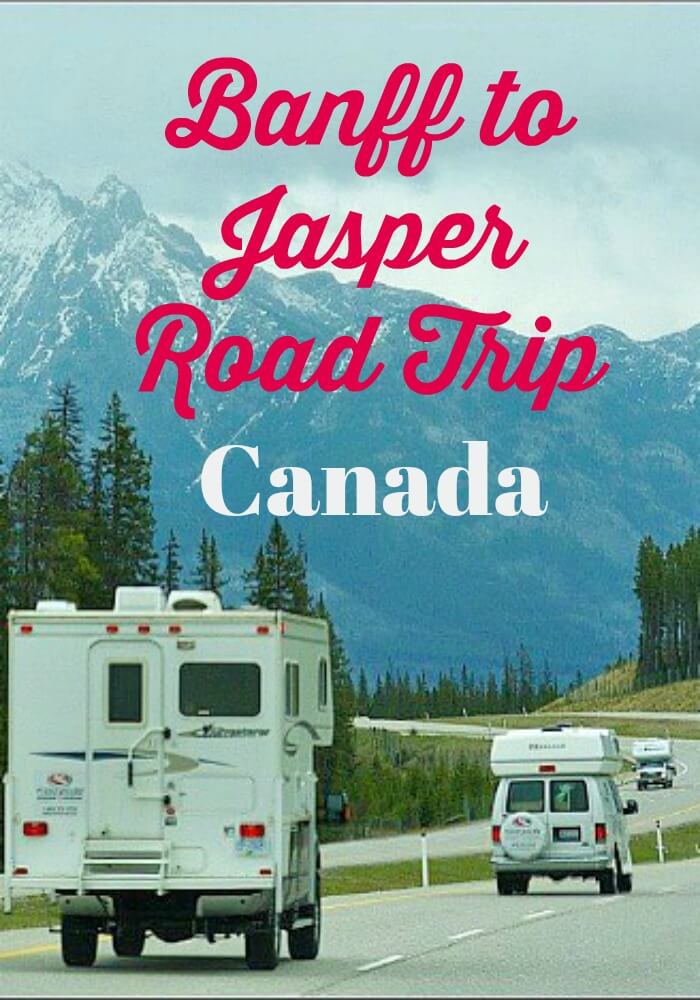
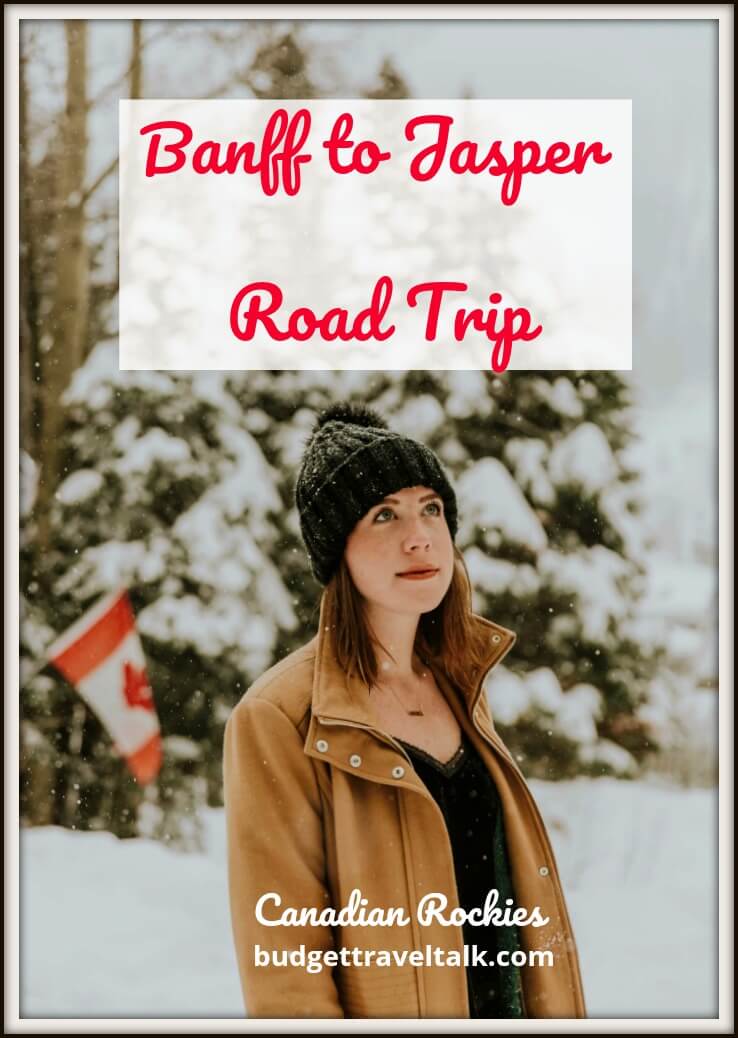
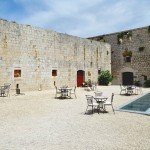
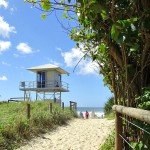
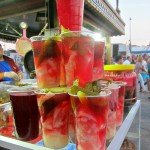
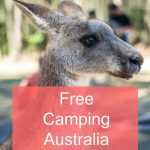
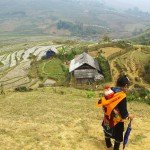
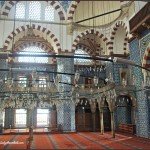

I can’t believe I never considered renting an RV! Thanks for that suggestion. It’s a trip I’ve wanted to do for a while.
I believe it is the best way, although a road trip of any kind would be great.
This is excellent Jan and we are hoping to combine an Alaskan cruise with a trip to Vancouver and the Rockies next year. So much info thank you!
What a mouth watering post!!
I spent a few weeks in BC a couple of years ago but am really keen to return to do the Icefield Parkway – And spend some time in the bit that you wanted to stay longer in haha!!
Mountains and lakes are simply sumptuous 🙂
Yes do it Linda. It was the whole Canadian Rockies drive from Banff to Jasper that blew my mind (and the detour to Emerald Lake in BC too). Next time we return I’m planning to do the Five Lake Hike and some others.
Wow, this is a comprehensive guide to the region which is undoubtably the most beautiful in Canada (I can say that being Canadian). Gorgeous. I haven’t been out west in a long time but we expect to do all this in a few years and will refer back. Great job.
Hi Frank, I am happy you liked my post. Since writing it I want to return to the Rockies because as you know you can never see and experience it all in a week. We are also great fans of Canada in general having also spent time in Toronto, Montreal, Quebec City and Province. It is beautiful there also. We have Canadian friends in Vancouver who lived in Australia for many years and we like to visit them. Canadians and Aussies are pretty similar I think. My main thought in doing this post was to give people some idea of what it is like before they arrive, especially so they allow enough time. Cheers.
We have a huge influx of RV’s aka Caravans here in our area of Greece in the summer and with few formal campgrounds around they park in the municipal lots, or at the side of the road or drive onto beach access ways and set up their temporary homes. Many are rentals and I can’t help but wonder how much they end up spending on their travels as fuel here is basically $8US a gallon. With wonderful studios for 25 – 40 a night I would think it might pencil out to be cheaper to drive a conventional car. So here’s a thought: you need to come this way and try it out and then write a blog post about it!! (I loved this one and have to admit that even living hours away from that part of Canada I’ve missed this area of the Rockies).
Hi Jackie, I think the RV’s are a great way to explore B.C. and the Rockies, but with the price of fuel in Greece, I think I’d hire a fuel efficient car and stay in studios. Horses for courses we say in Australia lol.